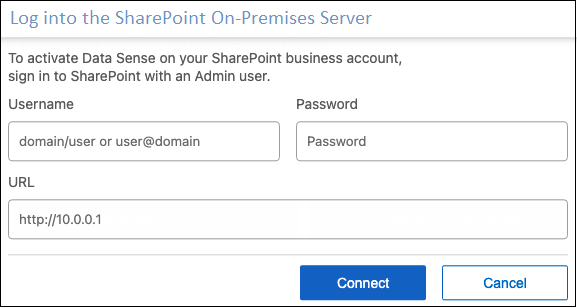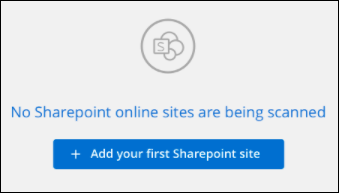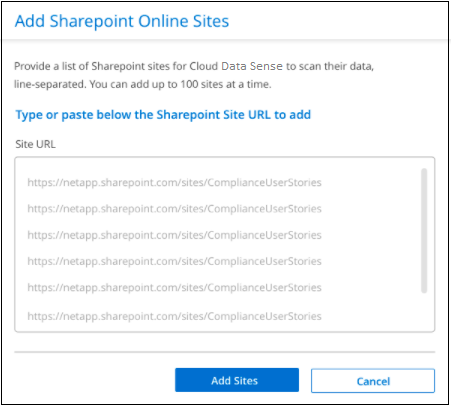Scanning SharePoint accounts
 Suggest changes
Suggest changes


Complete a few steps to start scanning files in your SharePoint Online and SharePoint On-Premise accounts with BlueXP classification.
Quick start
Get started quickly by following these steps, or scroll down to the remaining sections for full details.
 Review SharePoint prerequisites
Review SharePoint prerequisitesEnsure that you have qualified credentials to log into the SharePoint account, and that you have the URLs for the SharePoint sites that you want to scan.
 Deploy the BlueXP classification instance
Deploy the BlueXP classification instanceDeploy BlueXP classification if there isn't already an instance deployed.
 Log into the SharePoint account
Log into the SharePoint accountUsing qualified user credentials, log into the SharePoint account that you want to access so that it is added as a new data source/working environment.
 Add the SharePoint site URLs to scan
Add the SharePoint site URLs to scanAdd the list of SharePoint site URLs that you want to scan in the SharePoint account, and select the type of scanning. You can add up to 100 URLs at time - and up to 1,000 sites total for each account.
Reviewing SharePoint requirements
Review the following prerequisites to make sure you are ready to activate BlueXP classification on a SharePoint account.
-
You must have the Admin user login credentials for the SharePoint account that provides read access to all SharePoint sites.
-
For SharePoint Online you can use a non-Admin account, but that user must have permission to access all the SharePoint sites that you want to scan.
-
-
For SharePoint On-Premise, you'll also need the URL of the SharePoint Server.
-
You will need a line-separated list of the SharePoint site URLs for all the data you want to scan.
Deploying the BlueXP classification instance
Deploy BlueXP classification if there isn't already an instance deployed.
-
For SharePoint Online, BlueXP classification can be deployed in the cloud.
-
For SharePoint On-Premises, BlueXP classification can be installed in an on-premises location that has internet access or in an on-premises location that does not have internet access.
When BlueXP classification is installed in a site without internet access, the BlueXP Connector also must be installed in that same site without internet access. Learn more.
Upgrades to BlueXP classification software is automated as long as the instance has internet connectivity.
Adding a SharePoint Online account
Add the SharePoint Online account where the user files reside.
-
From the Working Environments Configuration page, click Add Data Source > Add SharePoint Online Account.

-
In the Add a SharePoint Online Account dialog, click Sign in to SharePoint.
-
In the Microsoft page that appears, select the SharePoint account and enter the user and password (Admin user or other user with access to the SharePoint sites), then click Accept to allow BlueXP classification to read data from this account.
The SharePoint Online account is added to the list of working environments.
Adding a SharePoint On-premise account
Add the SharePoint On-premise account where the user files reside.
-
From the Working Environments Configuration page, click Add Data Source > Add SharePoint On-premise Account.

-
In the Log into the SharePoint On-Premise Server dialog, enter the following information:
-
Admin user in the format "domain/user" or "user@domain", and admin password
-
URL of the SharePoint Server

-
-
Click Connect.
The SharePoint On-premise account is added to the list of working environments.
Adding SharePoint sites to compliance scans
You can add individual SharePoint sites, or up to 1,000 SharePoint sites in the account, so that the associated files will be scanned by BlueXP classification. The steps are the same whether you are adding SharePoint Online or SharePoint On-premise sites.
-
From the Configuration page, click the Configuration button for the SharePoint account.

-
If this is the first time adding sites for this SharePoint account, click Add your first SharePoint site.

If you are adding additional users from a SharePoint account, click Add SharePoint Sites.

-
Add the URLs for the sites whose files you want to scan - one URL per line (up to 100 maximum per session) - and click Add Sites.

A confirmation dialog displays the number of sites that were added.
If the dialog lists any sites that could not be added, capture this information so that you can resolve the issue. In some cases you can re-add the site with a corrected URL.
-
If you need to add more than 100 sites for this account, just click Add SharePoint Sites again until you have added all your sites for this account (up to 1,000 sites total for each account).
-
Enable mapping-only scans, or mapping and classification scans, on the files in the SharePoint sites.
To: Do this: Enable mapping-only scans on files
Click Map
Enable full scans on files
Click Map & Classify
Disable scanning on files
Click Off
BlueXP classification starts scanning the files in the SharePoint sites you added, and the results are displayed in the Dashboard and in other locations.
Removing a SharePoint site from compliance scans
If you remove a SharePoint site in the future, or decide not to scan files in a SharePoint site, you can remove individual SharePoint sites from having their files scanned at any time. Just click Remove SharePoint Site from the Configuration page.

Note that you can delete the entire SharePoint account from BlueXP classification if you no longer want to scan any user data from the SharePoint account.



 Release notes
Release notes